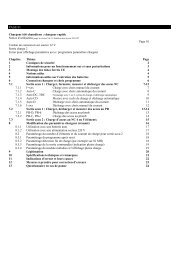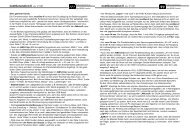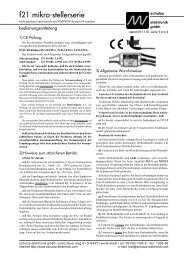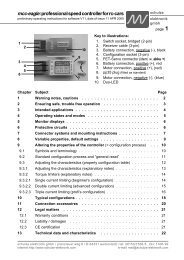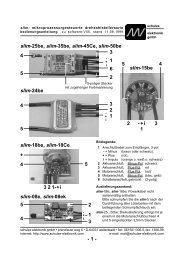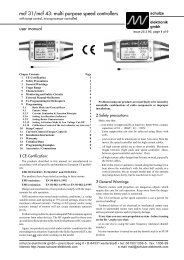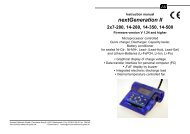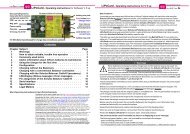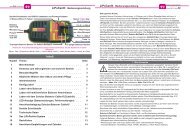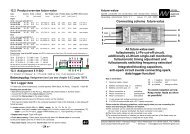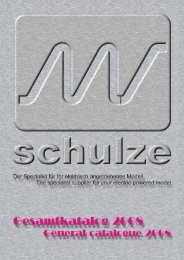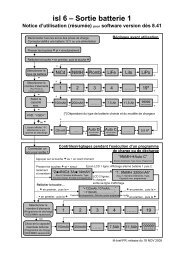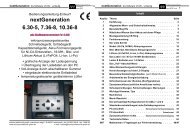nextGeneration II 2x7-280, 14-280, 14-350 - Schulze Elektronik GmbH
nextGeneration II 2x7-280, 14-280, 14-350 - Schulze Elektronik GmbH
nextGeneration II 2x7-280, 14-280, 14-350 - Schulze Elektronik GmbH
Create successful ePaper yourself
Turn your PDF publications into a flip-book with our unique Google optimized e-Paper software.
1<br />
2<br />
3<br />
4<br />
5<br />
6<br />
7<br />
8<br />
1<br />
2<br />
3<br />
4<br />
5<br />
6<br />
7<br />
8<br />
40<br />
Page Issue 03.10<br />
Fig. 23.8 Parameter screen battery 1<br />
1 ParameterSet ParameterSet battery battery 1<br />
1<br />
2 bType bType® bType LiPo LiPo cells cells® cells +B +B 5<br />
5<br />
3 prog3 prog3®fixCD prog3 fixCD cRate cRate®* cRate * * 1.0<br />
1.0<br />
4 cCurr cCurr®3.50A cCurr 3.50A quan> quan> quan>® quan> quan> <strong>350</strong>0<br />
<strong>350</strong>0<br />
5 dCurr dCurr®4.00A dCurr 4.00A time> time>® time> 1h30<br />
1h30<br />
6 cutOf cutOf®v-max cutOf v-max temp> temp>® temp> OFF<br />
OFF<br />
7 delay delay® delay 2min 2min diode diode® diode OFF<br />
OFF<br />
8 stora stora® stora NO NO NO refr. refr.® refr. OFF<br />
1<br />
Fig. 23.9 Curve screen battery 2<br />
0NiMH 0NiMH 00:00 00:00 0.00V 0.00V b<br />
2 autoC autoC (2.00A) (2.00A) 0mAh 0mAh a<br />
3 8V 8V<br />
t<br />
4<br />
t<br />
5<br />
6<br />
ready<br />
ready<br />
2<br />
7<br />
1 1 2 2<br />
2<br />
8 2V 2V 2V t t<br />
t<br />
1<br />
2<br />
3<br />
4<br />
5<br />
6<br />
7<br />
8<br />
Fig. 23.7 Curve screen battery 1<br />
5LiPo 5LiPo 00:00 00:00 0.00V 0.00V b<br />
3fixCD 3fixCD (3.50A) (3.50A) 0mAh 0mAh a<br />
8V 8V<br />
t<br />
t<br />
ready<br />
ready<br />
11 11<br />
11<br />
1 1 1 2<br />
2<br />
2V 2V 1234 1234 5 5 t<br />
t<br />
Fig. 23.10 Parameter screen battery 2<br />
ParameterSet ParameterSet battery battery 2<br />
2<br />
bType bType® bType NiMH NiMH NiMH cells cells® cells 0<br />
0<br />
prog. prog.®autoC prog. autoC cRate cRate® cRate -<br />
-<br />
cCurr cCurr®2.00A cCurr 2.00A quan> quan>® quan> 2000<br />
2000<br />
dCurr dCurr®4.00A dCurr 4.00A time> time>® time> 1h30<br />
1h30<br />
cutOf cutOf®sens. cutOf sens. temp> temp> temp>® temp> OFF<br />
OFF<br />
delay delay® delay 7min 7min diode diode® diode NO<br />
NO<br />
stora stora® stora NO NO refr. refr.® refr. OFF<br />
Fig. 23.11 charge quantity selection b.2<br />
Param. Param. Selection Selection batt2<br />
batt2<br />
ChargeCapacity ChargeCapacity cutOff<br />
cutOff<br />
+--------+<br />
+--------+<br />
| | 2.2 2.2 Ah| Ah| + + change<br />
change<br />
--> --> 2.0 2.0 Ah<br />
3.2 A) multiplied by the selected C-rate (in this<br />
case 1.0!). This current value is not crossed out so<br />
that you can choose another current manually.<br />
If the curve screen of battery 2 (Fig. 23.9) a push on<br />
changes to fig. 23.10, the parameter screen of<br />
battery 2. If you press again key<br />
, the screen changes back to 23.9 (curve screen).<br />
Hint:<br />
You also can press and alternately.<br />
Depending on the screen which is just displayed,<br />
the screens alternate between battery 1 2<br />
curve screens or between battery 1 2 parameter<br />
screens.<br />
If you press when the cursorbox in the<br />
parameter screen Fig. 23.10 is placed beside<br />
„quan>“ and the parameter „value“ in Fig. 23.13 is<br />
selected to „tabular“ then the Fig. 23.11 appears.<br />
Otherwise the parameter screen with the +/column<br />
cursor opens (Fig. 23.16 on the next<br />
page).<br />
<strong>nextGeneration</strong> <strong>II</strong> Firmware version V 1.00 and higher<br />
4.5 Lithium-Iron-Phosphate batteries (Li-FePO4)<br />
Operating<br />
instructions<br />
Issue 03.10, page<br />
Nominal voltage: 3,2 V / cell.<br />
Max. charge voltage: 3,65 V / cell.<br />
Min. discharge voltage: 2,0 V / cell.<br />
Selecting the fast charge current: Up to 4 C.<br />
Maximum contin. discharge current: Up to 20 C.<br />
Long time storage: The manufacturer recommends that 30% to 50% state of charge at 23 °C is<br />
best for a maximum time of 6 month. It offers a compromise between impedance creep and<br />
storage safety.<br />
Then discharge and charge to 50% capacity (use "quantity cutoff").<br />
Typical: These cells are even recommended as receiver batteries (2 cells have about the same voltage<br />
as 5 fully charged Nickel-cells), but also recommended for feeding a motor.<br />
Hint: The most common form of this battery type is the „Saphion“ or the "A123" cell.<br />
4.6 Lithium-Ion batteries (Li-Io & Li-Po)<br />
Nominal voltage LiIo:3,6 V / cell (SAFT)<br />
Nominal voltage LiIo/LiPo: 3,7 V / cell (SANYO, KOKAM)<br />
Max. charge voltage LiIo: 4,1 V +-40mV / cell (SAFT)<br />
(absolute limit 4.3 V / cell) LiPo: 4,2 V +-50mV / cell (MoliCel)<br />
Min. discharge voltage LiIo: 2,5 V / cell (MoliCel), 2,7 V / cell (SANYO)<br />
(absolute limit 2.3 V / cell) LiPo: 3,0 V / cell (KOKAM)<br />
Number of cells to be selected on the charger:<br />
Nominal voltage of LiPo-pack div.by nominal cell-voltage = cell count.<br />
--> 11,1 V LiPo-pack divided by 3.7 V => select 3 cells!<br />
If you would select more cells, the pack would explode during charging!<br />
Example: The Thunderpower TP8200 3s4p pack consists of 12 cells.<br />
4 of 2050mAh are connected parallel (4p) -> 4 * 2,05 Ah = 8200mAh.<br />
3 of the paralleled cells are connected in series (3s)-> 3*3,7V= 11,1 V.<br />
Selecting the fitting cell type:<br />
Select that battery type from the <strong>nextGeneration</strong><strong>II</strong> menu which characteristics match best with<br />
the data sheet of the battery manufacturer.<br />
Selecting the fast charge current:<br />
Charge current = 1 C (SANYO / KOKAM) or less (0,7 C PANASONIC) (C = nominal battery<br />
capacity).<br />
Maximum continous discharge current:<br />
1 ... 30 C (very new types), depending on cell type.<br />
Long time storage:<br />
Empty, i.e. discharged to the discharge voltage cut off level (see maintenance), at low temperature<br />
(-20°C bis +10°C) or at ambient temperature as described in chapter 12.3.<br />
Maintenance: Discharge with up to 1 C down to above listed discharge voltages. Always store<br />
these cells in the discharged state, if stored fully charged, the result can be a permanent<br />
reduction in capacity.<br />
When stored at +40°C or more charge additional every two months.<br />
Typical: Very good weight : energy ratio. High load cells have also a good weight : power resp.<br />
performance ratio.<br />
Hint: Many manufacturers direct how many cells are allowed to use in series and/or parallel use.<br />
The exact technical term of a Li-Po cell is Lithium-Ion-Polymer battery. These are hybrid cells and<br />
contain gelled electrolyte to enhance ion conductivity. The "true" (dry) Lithium-Polymer cells<br />
suffers from poor conductivity and work only with higher temperatures of more than 60°C.<br />
9



